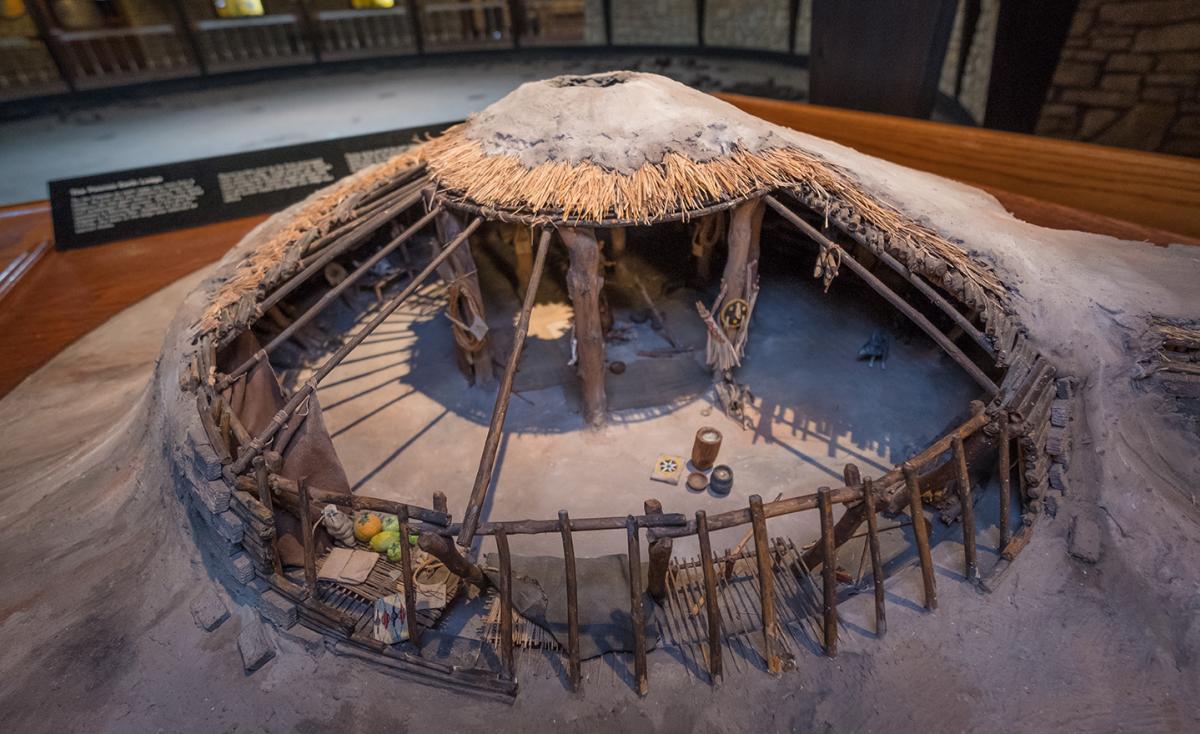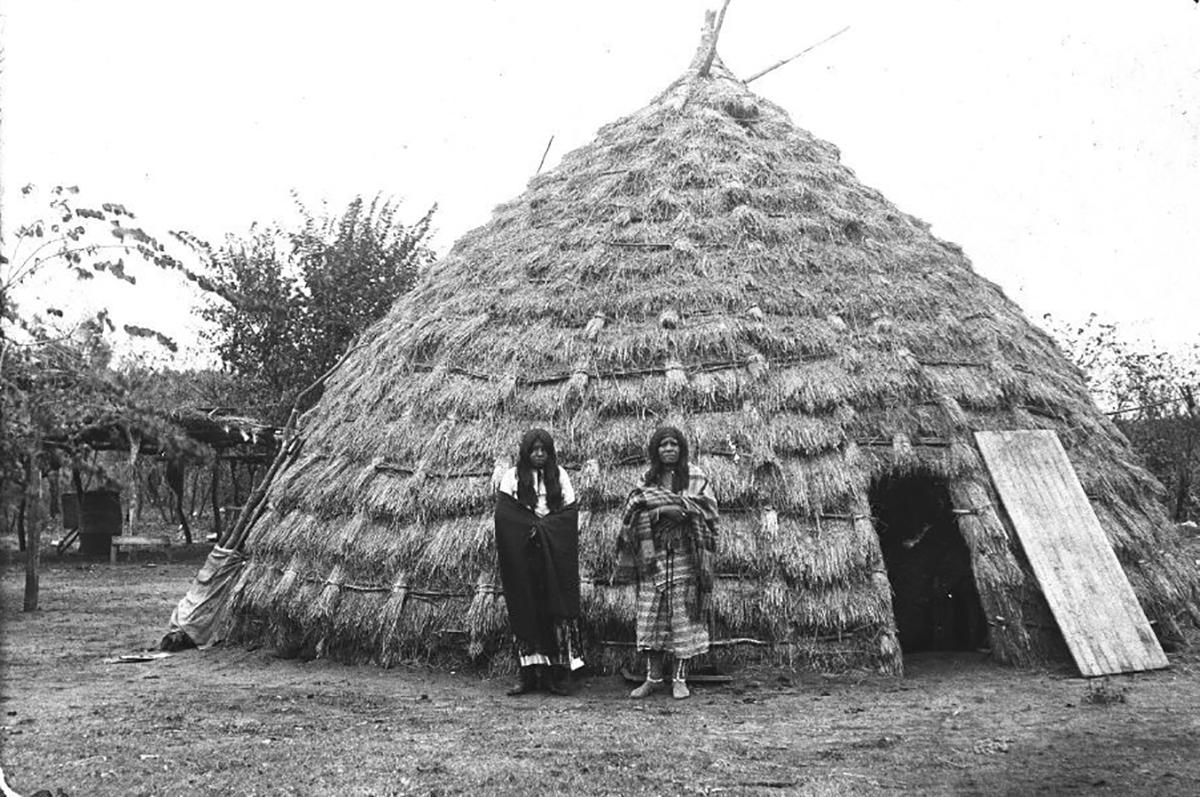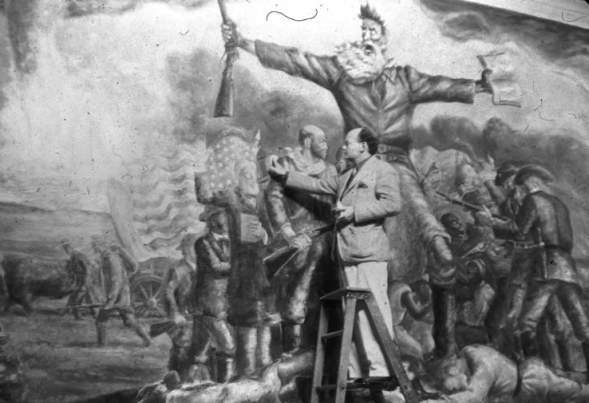Indigenous people’s oral histories and archeological research provide insight into the first Kansas homes
Long before Euro-American settlers built soddies and farmhouses in Kansas, Indigenous people populated the area and built houses with native materials. Thanks to oral and written history, the connected memory of living tribe members, and the diligent work of archaeologists, we know what those structures looked like and roughly how they functioned in day-to-day life. These structures were successfully used for thousands of years and continued to be built for all the same reasons people still build houses today: comfort, safety, and community.
Wichita grass houses
At the age of 79, Stuart Owings, an elder with the Wichita tribe living on the Wichita reservation in Anadarko, Oklahoma, thinks he may be one of the last living Wichita with first-hand knowledge of grass house building.
In 1975, Owings helped orchestrate the building of a grass house north of Anadarko. The biggest challenge, he says, was the gathering of the materials, which consisted of large pine poles, hundreds of locust and willow branches that had to be hand-stripped of bark, and finally, a huge supply of long-stem reeds to create the shingle-like thatch for the outside of the structure.
Owings notes there is some disagreement among Wichita elders about what type of material the Wichita used over the 500 years that they are believed to have built these homes in locations such as along the great bend of the Arkansas River, west of the Flint Hills near present-day McPherson.
“Some of them say you can use grass,” says Owings, who goes on to explain why he disagrees. “Years ago, some explorers who lived with the Wichita said they had domesticated a lot of wild animals—deer for one—that wandered around in the village. If you’ve got a house made of grass, what’s going to happen? They’ll eat it if they run out of food.”
Owings believes that the beehive-shaped “grass houses” were most commonly built with reeds, some of which are called “swamp grass” and could easily be found growing near rivers. These reeds are much sturdier than prairie grass, and they wouldn’t have attracted deer.
“Nothing will eat it because it’s too tough and there’s no food value,” Owings says. Traditionally, Owings notes, the Wichita would have used cedar for the large load-bearing poles, as cedar lasts longer and resists insects. “We contacted some Pueblo men, and they brought us a load of pine from New Mexico,” he says, detailing the building of the house near Anadarko.
About 40 volunteers assisted in building that grass house. “We got the bending forks set first, four on each side. They’re about eight foot apart—depends on how big the grass house is—then we laid poles across [the tops of] each of those forks.” Once this center structure was created, Owings said they set a larger ring of thinner poles outside this structure, bending them inward. “All these poles meet at the center up at the top of the grass house, and they’re tied to one or two—or sometimes I’ve seen three—hoops of heavy grape vines,” explains Owings. During the building process, two doorways at least six feet high were left open on either side of the structure, one facing east and once facing west, for spiritual purposes. “Mornings they’d pray to the east,” says Owings.
The black locust and willow branches were then secured perpendicular to the pine poles to create a sort of scaffolding, “about two feet apart, all the way to the top,” says Owings, “and the grass bundles are laid against those.”
While the men of the tribe would cut and set the poles, it was often the women and children who gathered the swamp grass and tied the bundles to the house, climbing the framework as they went. Starting at the bottom, the bundles were laid over top of each other, much like shingles, with the swamp grass about six inches thick near the ground. “As you get up higher on the grass house, the grass can be eight or ten inches thick. That’s why the grass house is cool in the summer and warm in the winter,” Owings says. A hole was left at the top for smoke from the cooking and heating fire to escape, though Owings says the tribe would’ve cooked and even slept outside during good weather. With regular maintenance, the grass houses could last for years, shedding rain and standing up to the winds of the Great Plains. Inside, bunk beds were located around the edge of the house. Higher up, the ribs of the house were used to hang supplies or hides, and to dry jerky.
Though the central support poles of the grass house were always aligned with the points of the compass, Owings was taught that they had another, symbolic meaning. “Some say those are directional poles,” says Owings. “But where the four poles met, one of my grandpas told me that was like man laying on top of his grass house—two of those poles were the legs and two were the arms. They prayed to God to protect their home, and he said that’s what those poles are.”
The grass houses of the Wichita were built to accommodate extended families. “Usually more than one family,” says Owings. “They would have grandmas and grandpas and in-laws and whoever they had room for.” When the Wichita had to leave their villages for hunting trips, they’d hide tools and other valuables in pits dug near the houses, and they’d camp in lean-tos or tipis with wooden poles and animal hides carried to the hunt.

Pawnee Earth Lodges
For much of the previous thousand years, the Pawnee were one of the largest and most powerful tribes of the Central Plains, with territory stretching from central Kansas up through Nebraska. The Republican River in Kansas is named for the Kitkahahki (Kit-KA-HAW-kee) band of Pawnees who were given the name “Republicans,” by French traders in the late 1700s. Virginia A. Wulfkuhle, former public archaeologist with the Kansas Historical Society and current editor of the Kansas Anthropologist newsletter, has spent many years studying the Pawnee, who built large earth lodges that held many people and even horses, when necessary.
"Those structures were very impressive,” she emphasizes. “Big. Some were 40 feet across. When you think about how much timber that took, and sod, and the weight that understructure had to bear—tons—they knew what they were doing.” The Pawnee earth lodge had a robust frame of wooden poles and stringers covered with branches, dirt and sod, with one doorway that usually faced east. The lodges held extended families of as many as 30 to 50 people and were substantial enough to hold young men who perched on top to watch for approaching enemies.
“The earth lodge house on the plains made a lot of sense, or they wouldn’t have been doing it for such a long time,” says Wulfkuhle. “I always think the settlers who came and built soddies and dugouts could have taken a cue from the Native Americans, but they resisted.”
Every able-bodied person in the tribe helped to build the earth lodges, says Wulfkuhle. “Everybody worked on it, but in many Native American cultures—including the Pawnee—the women owned the houses,” she explains. “The earth lodge itself is a microcosm of how they viewed the cosmos. Their whole spiritual concept was reflected in the arrangement of the earth lodge. It was the semi-cardinal directions that were important. Each of those semi-cardinal directions had meaning.” Each post she says, was assigned a set of spiritual associations. “They had a color, an animal, a kind of corn, a tree, the elements of climate like wind and lightning, clouds and thunder,” Wulfkuhle explains. “And in the house, the activities were divided into areas—there were certain things you would do in one area of the lodge but not in others. The cooking was done centrally, and there were storage pits in the floor, too.” Additional storage was found underneath raised beds located around the edge of the lodge.

The earth lodge was a place to sleep, eat and live during bad weather, and the extended entryway could even hold horses. With regular maintenance, the Pawnee earth lodge would last ten years or more. Like many people indigenous to the plains, the Pawnee would leave their earth lodges for weeks at a time to hunt bison, and during these times they would camp in tipis.
Kansa Earth Lodges
Lauren W. Ritterbush, professor of archaeology at Kansas State University, says that the traditional structures of the Kansa tribe were bark-covered houses, influenced by the materials available to them in their original wooded homeland east of the Mississippi River. As they moved into the plains and what would become Kansas in the late 1600s, the Kansa began covering their wooden structures with sod as opposed to bark, and their traditional earth lodge evolved from an oblong shape to a rounder one. The earliest Kansa archaeological sites in Kansas are located in Doniphan County along the Missouri River. “Then roughly around 1790, they moved to Blue Earth Village, which was just outside of Manhattan,” says Ritterbush. “We believe at that point they’re moving probably because of animosities with other tribes.”
Their new site was a hospitable location near the confluence of the Kansas River and the Blue River, says Ritterbush. Life near modern-day Manhattan worked out well for the Kansa. “At Blue Earth Village we believe there were about 160 houses altogether, so it was a good-sized village,” says Ritterbush. “They had a population at that time probably between 1200 and 1900 people, and they all lived in that one village. However, they did have enemies. The Pawnee to the north were their enemies, so they were threatened by raids occasionally.”
Today, modern Manhattan has completely covered the Blue Earth Village site. “We’re really fortunate that in 1819, a group of scientists who were traveling with Steven Long up the Missouri River were sent up the Kansas River to visit the Kansa at Blue Earth Village, and they had two artists along with them. So we have some really good descriptions of earth lodges, and also the first-known illustrations of earth lodges from anywhere on the Great Plains are from that actual village,” says Ritterbush. From these illustrations we know the Kansa earth lodges were built by setting a smaller ring of large, ten-foot or so poles in the center, with beams connected to a larger, but shorter, outer ring of poles. Like the Pawnee lodges, the Kansas’ lodges held a firepit in the center of the house with a smoke hole in the roof. The outside of the lodges was covered with dirt and sod. Eventually, grass would have grown over the lodge, further strengthening the structure.
Also like the Pawnee, the Kansa farmed corn, squash and beans, and would dry the corn and squash to eat throughout the winter. They also left their village for bison hunts, camping in tipis. “They would be gone for a lengthy time—certainly weeks if not months. They took a lot of things with them, but they would also store a lot of food in deep pits under the ground,” says Ritterbush.
The Visitation
Oral tradition holds, and archeological evidence supports, that the Pawnee and Wichita tribes are distantly related. “The Pawnees and the Wichitas are very close,” says Wichita elder Stuart Owings. “We still carry on the same practices we did a thousand years ago with the visitation.”
Each year the Pawnee and Wichita come together and camp for a couple of weeks, switching back and forth from Wichita to Pawnee land. (Both tribes are now located in Oklahoma.) Each year the tribes meet, share meals, exchange gifts, dance, pray, and honor each other. The designated “tobacco man” from the visiting tribe makes up a pouch of ceremonial smoking tobacco to be presented to the leader of the hosting tribe. The tobacco is then smoked and shared ceremonially. “It makes a complete circle with the Wichita on the south side and the Pawnees on the north side,” says Owings, who served as the Wichita tobacco man for many years. Plans for the following year’s visitation are made before saying their goodbyes and pledging to meet again in the next year.
Read more
To learn more about Indigenous housing, our experts recommend the book Plains Earthlodges: Ethnographic and Archaeological Perspectives edited by Donna C. Roper and Elizabeth P. Pauls, available through the University of Alabama Press, and Archaeology on the Great Plains, edited by W. Raymond Wood, available through the University Press of Kansas.
See Original Kansas Housing
Pawnee Indian Museum State Historic Site
480 Pawnee Trail, Republic, KS 66964
(785) 361-2255
The Pawnee Indian Museum is built over the archeological site of the remains of a Pawnee earth lodge.
Ways to Stay Connected
Read more about Kansas History
View ALlBlack History Trail of Geary County
Mar 08, 2024Jim Sands, President of the Black History Trail of Geary County / Photography by Nick Krug A county… Read More
Quindaro: A Great, Nearly Lost City of Free Peoples
Mar 07, 2024Photography by Andrea LaRayne Etzel & Carter Gaskins Quindaro was an abolitionist frontier city… Read More
From the Archives: Remembering John Steuart Curry
Jan 15, 2024Editor's Note: This article was originally published in the winter of 1992 by Don Lambert… Read More
From the Archives: Birth of the Helicopter
Jan 08, 2024Editor’s Note This article was originally featured in the winter issue of 1983 by Joan L… Read More
From the Archives: Kansas Outlaws
Oct 05, 2023The Sunflower State is known for its famous lawmen—but its infamous villains are legendary as… Read More










